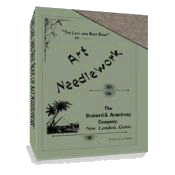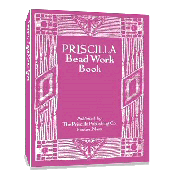All About Victorian Embroidered Centerpieces
Victorian Embroidered Centerpieces – No other piece of embroidery brings to mind “Victorian” than these. Victorian women loved them, not only because they dressed up their tables so beautifully, but it was also a perfect place to show off their handiwork.

Click on image to see more detail.
It was with these pieces that women allowed their imagination to take over. The shapes of the center-pieces could be made to suit the pattern they had chosen or designed – round, square, rectangle – it didn’t matter. All were quite acceptable as long as they were embroidered with care and taste. Most often, linen was the fabric of choice. The size depended totally on the embroiderer although a size around 20 x 24 inches was standard.
The best finish for the edge of this type of table piece had been learned through years of experience. Although fringe looked pretty when the item was new, repeated washings made the fringe tangle and frizz. Most Victorian ladies used the hemstitched hem or cut work edge. Once the edging was completed, the interesting part of making the embroidered table piece began.
It is here the embroiderer would take great pains to ensure that the colors used were quite acceptable and were stitched well. Since this piece was seen by almost everyone, no Victorian lady would allow anything but her best stitching used here. Beginners usually made their first centerpiece using a lighter, sketch pattern relying heavily on the Outline stitch. Lattice designs sprinkled with dainty flowers here and there were always appropriate. It was here that the new embroiderer would learn the craft of selecting and using several shades of the same color, using shading and not geometrical precision, in making a delightfully embroidered piece.
Victorian women were often reminded by the “experts” not to go overboard with the use of colors. Subtle colors were considered daintier and more appropriate to table linens. Prior to around the 1890’s, the only acceptable color used for table linens was white. Although color now was used, using bright colors was considered distasteful and gaudy.
If one did not choose to embroider with colored silks, one could use Honiton lace braids with great success. They were often arranged as single petals, circles and stars and appliquéd to the linen with white silk using the long and short stitch. The cloth was then cut away on the reverse side giving a beautiful cutwork appearance.
A Victorian lady with even just a small talent for sketching could make anything she wished into a centerpiece design. Many ladies found that, if necessary, they could turn their talent of embroidery into an income. What better way to supplement your household than by doing what you love?
Also see Embroidered Center-pieces.
The designs on the following pages were especially adapted to tray-cloths or centerpieces but the line of demarcation is so vague between the two that the purpose for which the embroidered piece was intended was only decided by its size and often simply a matter of choice.
Center-pieces
- Square
- Round
-
Oblong
-
Narcissus
- Violet
-
Morning Glory
- Bachelor Button
Return to top of Centerpieces page.
Return to Special Designs page.
The Last and Best Book of Art Needlework
Over 100 pages of authentic Victorian instructions and patterns from 1895!
FREE
Beeton's Book Of Needlework

433 pages!
Sign up for VEAC! Everything you wanted to know about Victorian embroidery, needlework, crafts and more!
Priscilla Bead Work Book
Make Beautiful Victorian Beaded Purses, Jewelry & Accessories - Starting
TODAY!



